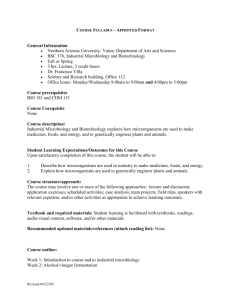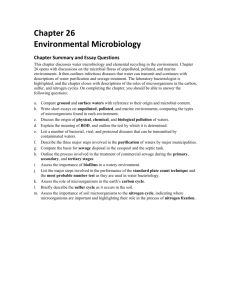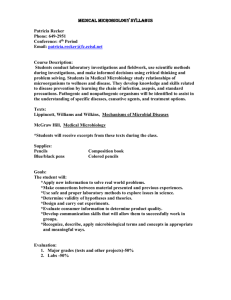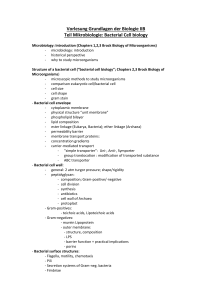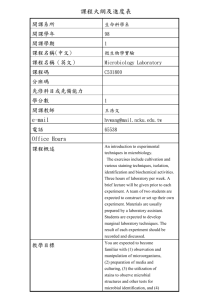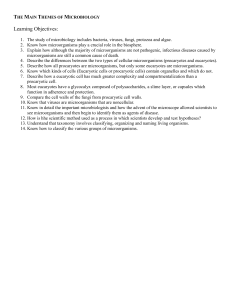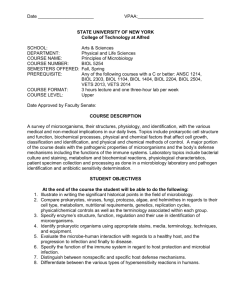Microbiology Syllabus - Wilson School District
advertisement
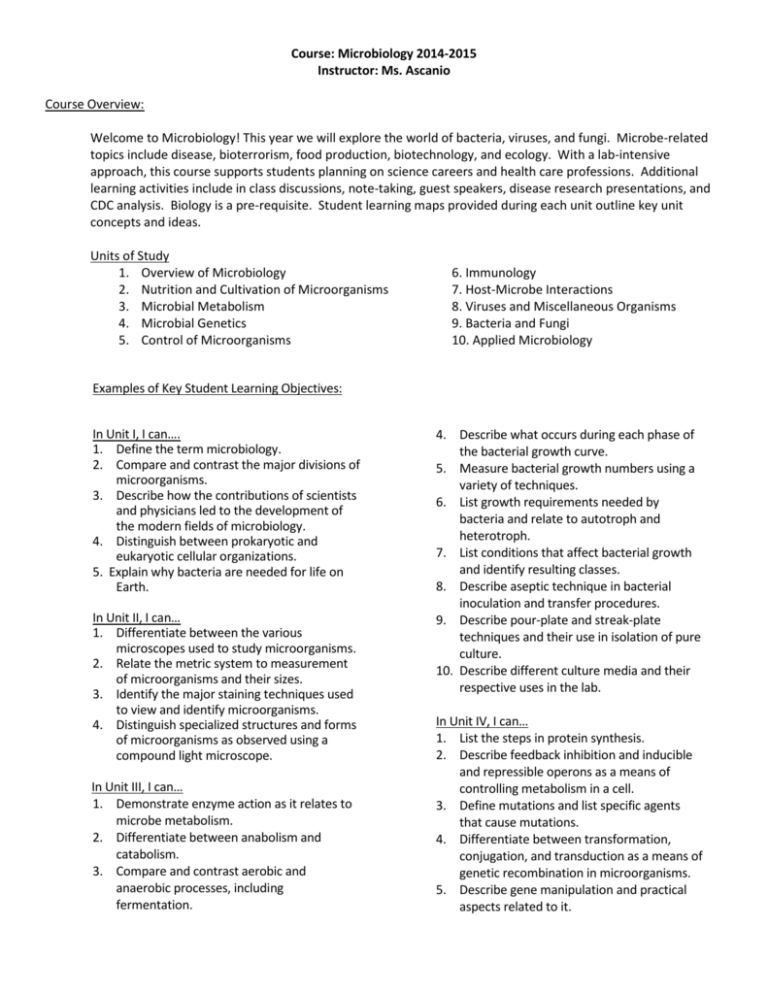
Course: Microbiology 2014-2015 Instructor: Ms. Ascanio Course Overview: Welcome to Microbiology! This year we will explore the world of bacteria, viruses, and fungi. Microbe-related topics include disease, bioterrorism, food production, biotechnology, and ecology. With a lab-intensive approach, this course supports students planning on science careers and health care professions. Additional learning activities include in class discussions, note-taking, guest speakers, disease research presentations, and CDC analysis. Biology is a pre-requisite. Student learning maps provided during each unit outline key unit concepts and ideas. Units of Study 1. Overview of Microbiology 2. Nutrition and Cultivation of Microorganisms 3. Microbial Metabolism 4. Microbial Genetics 5. Control of Microorganisms 6. Immunology 7. Host-Microbe Interactions 8. Viruses and Miscellaneous Organisms 9. Bacteria and Fungi 10. Applied Microbiology Examples of Key Student Learning Objectives: In Unit I, I can…. 1. Define the term microbiology. 2. Compare and contrast the major divisions of microorganisms. 3. Describe how the contributions of scientists and physicians led to the development of the modern fields of microbiology. 4. Distinguish between prokaryotic and eukaryotic cellular organizations. 5. Explain why bacteria are needed for life on Earth. In Unit II, I can… 1. Differentiate between the various microscopes used to study microorganisms. 2. Relate the metric system to measurement of microorganisms and their sizes. 3. Identify the major staining techniques used to view and identify microorganisms. 4. Distinguish specialized structures and forms of microorganisms as observed using a compound light microscope. In Unit III, I can… 1. Demonstrate enzyme action as it relates to microbe metabolism. 2. Differentiate between anabolism and catabolism. 3. Compare and contrast aerobic and anaerobic processes, including fermentation. 4. Describe what occurs during each phase of the bacterial growth curve. 5. Measure bacterial growth numbers using a variety of techniques. 6. List growth requirements needed by bacteria and relate to autotroph and heterotroph. 7. List conditions that affect bacterial growth and identify resulting classes. 8. Describe aseptic technique in bacterial inoculation and transfer procedures. 9. Describe pour-plate and streak-plate techniques and their use in isolation of pure culture. 10. Describe different culture media and their respective uses in the lab. In Unit IV, I can… 1. List the steps in protein synthesis. 2. Describe feedback inhibition and inducible and repressible operons as a means of controlling metabolism in a cell. 3. Define mutations and list specific agents that cause mutations. 4. Differentiate between transformation, conjugation, and transduction as a means of genetic recombination in microorganisms. 5. Describe gene manipulation and practical aspects related to it. In Unit V, I can… 1. List and describe physical methods and microbial control. 2. Define thermal death point and thermal death time. 3. Describe the mechanism by which moist heat, dry heat, and radiation kill microorganisms. 4. Differentiate between antiseptics and disinfectants. 5. Define antibiotic and list examples along with their modes of actions in microbial control. 6. Define chemotherapy and list examples of synthetic drugs along with their modes of action in microbial control. 7. Define minimal inhibitory concentration (MIC). 8. List mechanisms of antibiotic resistance developed by some microorganisms. In Unit VI, I can… 1. Define infection, pathogen, and virulence. 2. Differentiate between normal flora and pathogens. 3. List ways in which microbes counteract immunity. 4. Differentiate between exotoxins and endotoxins. 5. List the stages of disease. 6. Contrast innate, acquired, specific, and nonspecific immunity. 7. Describe the lines of defense the body uses to prevent pathogens from establishing themselves. 8. Define and describe antigens and antibodies. 9. List the major classes of immunoglobulins and describe each. 10. Describe the primary and secondary responses to antigenic stimuli. 11. Describe the functions of the B-cells, and Tcells in the immune response. 12. Distinguish between humoral and cell mediated immunity. 13. Explain the medical role of monoclonal antibodies. 14. Define hypersensitivity and describe the types of allergic reactions. 15. Describe hemolytic disease of the newborn and how it can be prevented. 16. Describe the role of immunity in the rejection of tissue transplants and the growth of tumors. 17. Discuss autoimmune diseases. 18. Differentiate between active and passive immunity. 19. List and describe pros and cons associated with vaccination. In Unit VII, I can… 1. Describe how a pathogen establishes infection. 2. Define incubation and its importance in the spread of infectious disease. 3. List routes by which pathogens exit a host. 4. Define epidemiology, mortality, morbidity, and epidemic. 5. Explain how microorganisms can be used in bioterrorism. In Unit VIII, I can… 1. Describe the size, range, organization, and distinctive structures of viruses. 2. Explain virus replication. 3. Describe the current theories linking viruses with tumors and cancer. 5. List diseases, modes of infection and methods of prevention or treatment for several viruses. 6. Identify current and experimental methods used to control viral infection. 7. Describe the morphology, chemistry, and diseases caused by prions. In Unit IX, I can... 1. Describe the morphology, cultural needs, identifying tests, diseases, and epidemiology of several bacterial and fungal species. 2. Define “mycoses” and differentiate between superficial and systemic forms. 3. Define “dimorphism” as it applies to fungi. In Unit X, I can… 1. Connect pathogenic microorganisms found in water with the diseases they cause. 2. Evaluate methods used to test water for fecal contamination. 3. List examples of microorganisms that cause foods to spoil. 4. Describe methods to preserve food. 5. Explain the cause of food borne diseases. 6. Identify the roles of microorganisms in the production of antibiotics, vaccines, useful proteins, and drugs. Potential Inquiry-Based Laboratory Activities (Subject to Change) 1. Microscopy 2. Sterile Practice 3. Staining Cells: negative, gram, acid fast, etc. 4. Isolation Techniques: dilution techniques, streaking, and filtration 5. Fermentation 6. Microbes in Our Environment and On/In Our Bodies 7. Carbohydrate Catabolism 8. Protein Catabolism: Gelatin Hydrolysis, Indole Test 9. Fungi: Yeasts and Molds 10. Helminths Survey 11. Physical and Chemical Methods of Control 12. Effectiveness of Hand Scrubbing 13. Selective and Differential Media 14. Antimicrobial Testing 15. Identification of Unknown Bacteria Class Course Goals: *Increased appreciation for the connection of microbiology with our daily lives. *Application of Microbiology to fields of Medicine and Ecology. *Development of skills to benefit student in future endeavors. *Better understanding of one’s self as a learner. *Mastery of scientific concepts as per the state standards. Assistance: I am available most days before or after school to assist students. Contact information is listed below. This information is also found on my teacher page along with other class resources. Visit that site frequently. E-mail: ascmeg@wilsonsd.org (Note: e-mails can usually be responded to more rapidly) Phone: 610-670-0180 extension 4268 Room: E-433 Grading: Each marking period, 70% of the earned grade comes from tests and performance assessments. The other 30% comes from other student work including quizzes, class work, mini-labs, and projects. Homework is assigned regularly and completion is expected to assist in mastery of course content and skills. Quizzes may be announced or unannounced, but tests will always be announced. Students and parents are responsible for monitoring student grades. Tips for Success: *Pay attention during class and take notes. The more work done in class, the less out of class time needed. *Complete all assignments, tests, and quizzes. *Spend a little time each night reviewing to avoid cramming. *Find connections in text, class activities, and homework. *Make use of all resources provided for you. *Ask questions. Write down questions as they come so you do not forget to ask. I look forward to a successful year of microbiology here at the Wilson School District!

